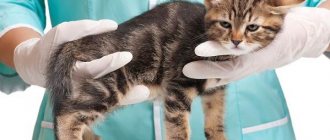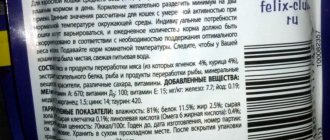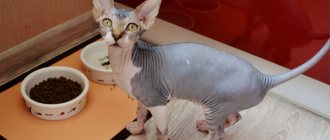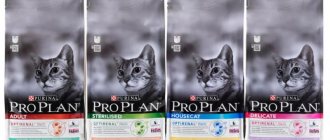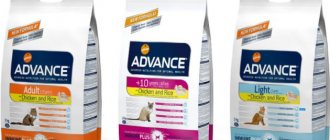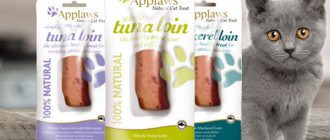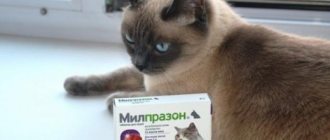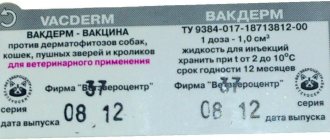Save the article:
Infections that affect the skin, fur and claws of a cat are much easier to prevent than to treat. For these purposes, practice-tested vaccines are used. Veterinarians often recommend Vacderm F (Vacderm-F) for cats. It is prescribed for the treatment and prevention of various types of lichen. Compliance with all points of the instructions for use of the vaccine guarantees a minimum number of side effects and the effectiveness of the product.
Purpose of the drug
Vakderm F is a vaccine intended for the prevention and treatment of various forms of dermatophytosis in animals. The formula was developed by Moscow, which is also the manufacturer of this medication.
global $ads_google; //data-ad-slot=”2475549904″ $ads_google = empty($ads_google) ? false : true; ?> if ($ads_google == false) {?>
$ads_google = true; ?> } ?>
Dermatophytosis is a contagious disease that is classified as zoonotic. Sick cats are sources of infection for other animals and humans. The causative agent is microscopic pathogenic fungi of several types. Dermatophytoses in cats manifest themselves in the form of single or multiple scaly inflammations on the skin and integument.
Under the influence of Vakderm F, the cat’s protection against ringworm and other types of lichen is enhanced.
Pets with weakened immune systems and kittens whose age has not yet reached 12 months are most susceptible to dermatophytosis. To prevent infection or stop the development of microsporia and trichophytosis, the Vakderm F vaccine is used.
Vaccinating a cat against lichen: pros and cons
There was initial excitement about shingles vaccines, but their use in small pets faded in Europe and the United States. Currently, there is not a single imported vaccine against dermatophytosis - microsporia and trichophytosis - on sale; these drugs have been withdrawn from the market and are no longer produced.
There are three reasons for this:
1) among domestic cats and dogs, the incidence of ringworm in the West is at an extremely low level;
2) post-marketing studies revealed extremely low, at the level of statistical error, effectiveness of preventive vaccination;
3) it was not possible to find out whether there is a therapeutic effect of the vaccine, since with a mild course, within the time specified in the instructions for the appearance of immunity (20-25 days after the second vaccination, which is separated from the first by another 14 days), dermatophytoses often resolve spontaneously.
Find out more about the signs of lichen in cats>>>
In Russia, vaccines against dermatophytosis are produced and used to this day.
However, leading dermatologists do not recommend this method of treatment to their patients, again finding no evidence of the effectiveness of such vaccination.
Proponents of vaccinations against dermatophytes point out that there are no studies proving the uselessness of these drugs. To this, the famous dermatologist Ekaterina Kuznetsova objects that such studies cannot happen for purely financial reasons; there are no those who benefit from paying for them. And we need to start from works that prove the need for such vaccines, but none of these drugs have been tested in a double-blind, placebo-controlled study. But there are many antifungal medications, both in ointments and tablets, that help quickly and effectively get rid of ringworm. Considering the relatively low prevalence of the disease among domestic cats and dogs, this is sufficient.
Find out more about the types of lichen in cats and how to treat it>>>
Some Western sources from 10-15 years ago contain evidence that vaccines against ringworm are effective for treating this disease as part of complex therapy (that is, together with antifungal tablets and/or ointments). Such data has already been excluded from modern publications.
Release form and composition
Vakderm F is marketed as a liquid for injection. The sterile solution has a pink tint and a uniform consistency without additional inclusions. The vaccine is bottled in hermetically sealed glass bottles of various capacities. One ampoule can contain different amounts of the drug: 1 ml, 2 ml or 10 ml. Each glass container is closed with a rubber stopper, which is secured with an aluminum cap. Vials of the Vakderm F vaccine are arranged in cardboard packs of 10 pieces.
It is important to remember that Vakderm F for lichen should be used within 30 minutes after opening the ampoule
The shelf life of the drug against dermatophytosis is limited to 12 months. After this time, the liquid must be disposed of. This can be done without the use of special measures (heating the vaccine or other inactivation method). After purchase, the medication must be kept out of the reach of small children. The vaccine deteriorates in light and at room temperature, so it is stored in the refrigerator at a temperature of +2 to +10 degrees.
The fresh vaccine contains pure cultures of three microscopic fungi, which are specially grown in a nutrient medium. Biological components include species:
- Microsporum
- Trichophyton
- Epidermophyton
The concentration of fungal cells in one ampoule is 50-80 million/cm3. During the vaccine production process, fungi are inactivated with formalin taken at a concentration of 0.3%. The same substance serves as a stabilizer in the composition of the drug. The medicinal properties of the vaccine are reinforced by the addition of the immunomodulator Ribotan at a working concentration of 0.2%. This substance enhances the immune response in the cat’s body when infected with lichen.
The Vacderm vaccine, which is similar in composition (without the “F” suffix), is intended for a wide range of domestic animals, while Vacderm-F is specifically for cats
Shelf life and storage conditions
Vakderm can be stored for a year from the production date (as we have already mentioned, it is indicated on each ampoule and bottle). Storage conditions: refrigerator (permissible temperature 2-10 °C).
For safety reasons, it is necessary to prevent children from having access to ampoules or vials.
It is prohibited to use:
- the drug has expired or has been stored in violation of the above conditions;
- ampoules or vials on which the necessary markings are missing or erased (we have already provided a list of information that must be applied by the manufacturer to the vaccine container);
- bottles (ampoules) that are damaged, not hermetically packaged, or opened more than half an hour ago;
- a drug whose appearance does not correspond to what was declared (has a different color or consistency, there is sediment or foreign impurities, mold, etc.).
If any of the above circumstances are present, the vaccine is discarded
This process does not require any additional disinfection measures, just ordinary precautions.
To vaccinate or not to vaccinate your cat against lichen is a question that every cat owner decides for himself. This vaccination is not mandatory by international standards, but it is included in the “vaccination calendar” of many veterinary clinics. "Vakderm" is one of the top three most common drugs used for these purposes, its price is quite affordable, and side effects are minimal.
A loving owner is concerned not only with the appearance of the pet, but also with its health. Unfortunately, cats are often susceptible to skin diseases such as dermatitis. Its peculiarity is that this disease can become dangerous for the cat owner. Preventing a disease is easier than treating it. Any experienced veterinarian will confirm this. In this article you will find instructions on how to combat lichen with the help of medications.
Therefore, it is worth taking care of your furry pet in advance by carrying out preventive vaccination
using the drug Vakderm-F. He will protect the cat:
When visiting a veterinary clinic, the cat owner will be offered vaccinations.
using Vakderm or Vakderm-F. Let's look at their distinctive features and determine which drug is right for your cat.
Instructions for use Vakderma F
Vaccinating a cat against parasitic fungi requires adherence to the schedule and dosage. The vaccine against dermatophytosis is used twice, taking a break of 10-14 days. After about a month (25-30 days), the cat develops its own immunity against lichen pathogens. The acquired immune reaction remains in the pet’s body for up to one year.
global $ads_google; //data-ad-slot=”2475549904″ $ads_google = empty($ads_google) ? false : true; ?> if ($ads_google == false) {?>
$ads_google = true; ?> } ?>
10-12 days before the scheduled vaccination, the cat must undergo deworming and treatment against ectoparasites with suitable drugs. The anthelmintic and insecticide are given to the pet on different days to reduce the risk of intoxication. For vaccination with Vakderm F, the dosage is chosen based on the age of the cat. For three-month-old and younger kittens, a single dose is 0.5 ml. For older pets – 1 ml of product.
It is important to follow the prescribed immunization schedule. If the appointed date is missed, it is necessary to inject the vaccine as soon as possible
How and where to inject
Before drawing the vaccine into the syringe, the bottle is heated to 36-37 degrees. This is done by holding the ampoule in the palm of your hand or placing it in a water bath. The vaccine must be administered intramuscularly. In this case, the first and second injections are given in different paws of the cat. A suitable injection site is the inner or back of the thigh. The bone on the limb is felt so as not to hit it. This is especially important if the vaccine is given to a skinny cat. According to the instructions, the site chosen for the injection is treated with a cotton pad soaked in 70% alcohol. The needle is inserted to a depth of 1-1.5 cm and the solution is slowly injected.
Treat or vaccinate for ringworm?
Many owners are wondering whether it is worth vaccinating their cat, why expose it to unnecessary stress and exposure to the vaccine. If a cat gets sick, then we will treat it, and what if it overcomes such an illness, it will not have contact with sick and stray animals. Let's try to figure out this difficult issue.
As you know, if a cat gets sick, not only the animal is at risk, but the whole family is at risk. In humans, lichen is difficult to treat and takes a long time, because the fungus that causes the skin disease is quite tenacious; it can withstand direct sunlight, frost, and some antifungal medications and disinfectants.
After lichen, the following complications may occur in cats: meningitis, complex skin infections, blindness, pneumonia, neuralgia. If a vaccinated cat gets shingles, the disease will go away with milder symptoms and it will take much less time to fully recover. When the injection takes place against a healthy background, in accordance with the established schedule, then there is nothing to fear, the vaccine will only bring benefits.
Possible complications
The vaccine manufacturer warns that after administration of Vakderm-F, the cat may become drowsy or have a fever. This state lasts a maximum of three days. Some owners note that a swelling forms at the injection site after vaccination. To speed up the resorption of the seal, it is recommended to lubricate the problem area once with an alcohol solution of iodine.
If a cat begins to noticeably show signs of lichen after vaccination, it means that the animal has already been infected and the incubation period has passed. In such a situation, after two weeks it is also necessary to re-inject the vaccine, maintaining the dosage according to the instructions for use. There are no more serious complications after Vakderm F.
Methods of infection
Many owners think that they can become infected through direct contact with a sick or stray animal, but:
- You can also become infected with lichen at exhibitions; sometimes your pet may not have significant symptoms of the disease. He is a carrier, due to his excellent immunity, he infects others, and he himself remains outwardly healthy and well-groomed.
- It is also possible for a pet that has never gone outside to “catch” this skin disease. The owner can bring fungal spores on shoes or hands.
- A pet walking on the street or in the countryside in the summer can easily become infected by walking on grass or soil, which may contain spores of this fungus, which causes a complex skin disease.
- A predisposition to lichen can be inherited.
Pros and cons of the drug
The widespread use of Vakderm F is explained by several advantages. These include:
- prolonged action;
- ease of use;
- possibility of prevention and treatment.
global $ads_google; //data-ad-slot=”2475549904″ $ads_google = empty($ads_google) ? false : true; ?> if ($ads_google == false) {?>
$ads_google = true; ?> } ?>
When choosing Vacderm-F for cat vaccination, you should also remember about the existing disadvantages that either limit its use or impose certain requirements. The disadvantages include:
- Specific storage conditions for the product and a relatively short shelf life.
- Incompatibility of the drug for lichen with other medications of similar action.
- Presence of contraindications and side effects after vaccination.
Preparing cats for vaccination
Vaccines against lichen can be used for cats from two months of age. A schedule of preventive and therapeutic immunizations is prescribed by a veterinarian. Vaccination should be entrusted to specialists from veterinary clinics.
Before you give your cat a preventive vaccination against lichen, show your pet to a veterinarian. Only clinically healthy animals can be vaccinated!
Vaccines against dermatomycosis are administered intramuscularly into the femoral muscle, between the shoulder blades
2-3 weeks before routine immunization, it is imperative to deworm your pet using special anthelmintics. If the animal is infected with worms, the effect of vaccination will be minimal.
It is also necessary to treat the coat against fleas, ticks, and lice-eaters. For these purposes, use insecticidal-acaricidal drops, sprays, aerosols, shampoos, which can be purchased at veterinary pharmacies, veterinary hospitals, and pet stores.
Analogs
The Vakderm F vaccine has two analogues that can replace it. You can use another medication only after consulting a veterinarian. Since only a specialist is able to assess the cat’s health, the feasibility and possibility of replacement. Each of the alternative means has its own characteristics.
Microderm is a combination of dry matter and dilution solution. The therapeutic effect in cats begins to appear 10-15 days after the injection. Immunity is formed from 20-30 days. The shelf life of this vaccine is one and a half times higher than that of Vakderma-F
Polivak-TM is a ready-made injection solution containing eight types of inactivated fungi. To achieve the effect, it is recommended to administer the vaccine twice or three times. The shelf life is 18 months.
Vacderm vaccine
The biological product is produced in bottles with a volume of 1-450 cm3. Each milliliter of suspension constitutes one vaccination dose.
The cost of one dose in January 2022 was 90 rubles.
Application
The vaccine forms one-year immunity to dermatophytosis 4 weeks after a double intramuscular injection with an interval of 10-14 days. The biological product causes a local reaction, so when it is administered, the paws of the vaccinated animals alternate.
The immunizing agent has a therapeutic effect, and the volumes of the therapeutic and preventive doses do not differ. Vaccinations are carried out in accordance with the scheme:
| Kind of animal | Age, days | Live weight, kg | Dose, ml |
| Dog | >60 | <5 | 0,5 |
| >5 | 1,0 | ||
| Cat | >30<90 | 0,5 | |
| >90 | 1,0 | ||
| Rabbit | <50 | 0,5 | |
| >50 | 1,0 | ||
| Furry animal | >30<50 | 0,5 | |
| >50 | 1,0 |
To prevent the formation of antibodies from being hampered by infestation, animals are dewormed 10 days before vaccination.
If the vaccination provoked a disease, or immunization is carried out for therapeutic purposes, after the first vaccination the biological product is injected twice with an interval of 10-14 days.
Side effects and contraindications
In dogs, swelling may form at the injection site, and cats may become drowsy. Unpleasant symptoms disappear on their own after 2-3 days. Vaccination is postponed if the animal has a fever or another disease other than trichophytosis.
